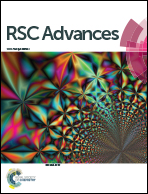Dual-phase phosphor-in-glass based on a Sn–P–F–O ultralow-melting glass for warm white light-emitting diodes
Abstract
Herein, a novel alkaline metal fluoride-modified Sn–P–F–O ultralow-melting glass was designed to find a possible application of it as a host matrix for dispersing commercial phosphors. X-ray diffraction, differential scanning calorimetry, X-ray photoelectron spectroscopy, and Fourier transform infrared (FTIR) spectroscopy were adopted to study the related glass structure. Importantly, a dual-phase phosphor-in-glass (PiG) inorganic color converter was successfully prepared by directly co-sintering the mixture of Sn–P–F–O-based glass components, Ce3+:Y3Al5O12 yellow phosphors, and Eu2+:CaAlSiN3 red phosphors at a temperature as low as 350 °C; moreover, the yellow to red tunable luminescence was easily realized via modifying the content of the red phosphor in the glass matrix. As a consequence, warm white light-emitting devices with improved optical performances were easily achieved by combining the fabricated dual-phase PiG with an InGaN blue chip.



 Please wait while we load your content...
Please wait while we load your content...